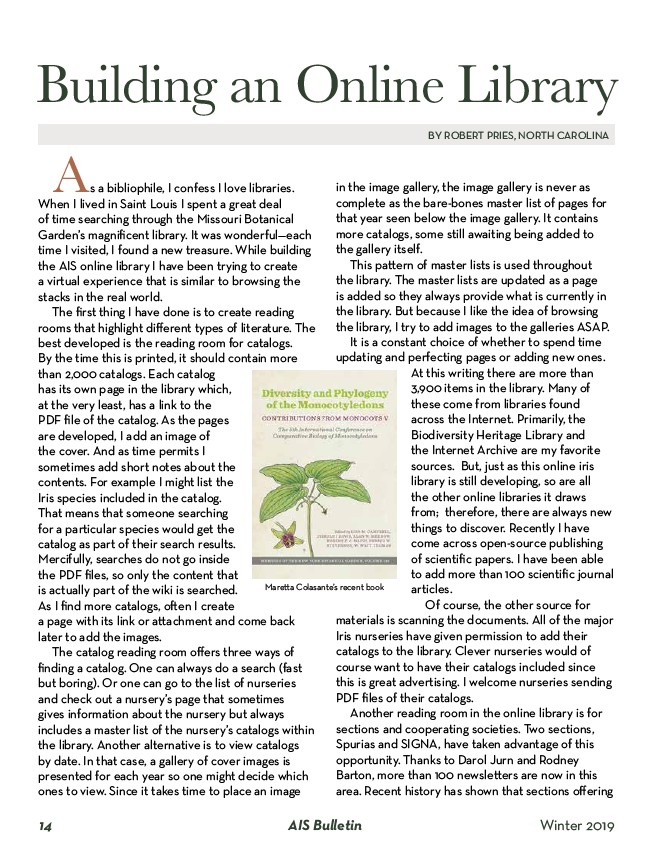
Building an Online Library
BY ROBERT PRIES, NORTH CAROLINA
As a bibliophile, I confess I love libraries.
When I lived in Saint Louis I spent a great deal
of time searching through the Missouri Botanical
Garden’s magnificent library. It was wonderful—each
time I visited, I found a new treasure. While building
the AIS online library I have been trying to create
a virtual experience that is similar to browsing the
stacks in the real world.
The first thing I have done is to create reading
rooms that highlight different types of literature. The
best developed is the reading room for catalogs.
By the time this is printed, it should contain more
than 2,000 catalogs. Each catalog
has its own page in the library which,
at the very least, has a link to the
PDF file of the catalog. As the pages
are developed, I add an image of
the cover. And as time permits I
sometimes add short notes about the
contents. For example I might list the
Iris species included in the catalog.
That means that someone searching
for a particular species would get the
catalog as part of their search results.
Mercifully, searches do not go inside
the PDF files, so only the content that
is actually part of the wiki is searched.
As I find more catalogs, often I create
a page with its link or attachment and come back
later to add the images.
The catalog reading room offers three ways of
finding a catalog. One can always do a search (fast
but boring). Or one can go to the list of nurseries
and check out a nursery’s page that sometimes
gives information about the nursery but always
includes a master list of the nursery’s catalogs within
the library. Another alternative is to view catalogs
by date. In that case, a gallery of cover images is
presented for each year so one might decide which
ones to view. Since it takes time to place an image
in the image gallery, the image gallery is never as
complete as the bare-bones master list of pages for
that year seen below the image gallery. It contains
more catalogs, some still awaiting being added to
the gallery itself.
This pattern of master lists is used throughout
the library. The master lists are updated as a page
is added so they always provide what is currently in
the library. But because I like the idea of browsing
the library, I try to add images to the galleries ASAP.
It is a constant choice of whether to spend time
updating and perfecting pages or adding new ones.
At this writing there are more than
3,900 items in the library. Many of
these come from libraries found
across the Internet. Primarily, the
Biodiversity Heritage Library and
the Internet Archive are my favorite
sources. But, just as this online iris
library is still developing, so are all
the other online libraries it draws
from; therefore, there are always new
things to discover. Recently I have
come across open-source publishing
of scientific papers. I have been able
to add more than 100 scientific journal
articles.
Of course, the other source for
Maretta Colasante’s recent book
materials is scanning the documents. All of the major
Iris nurseries have given permission to add their
catalogs to the library. Clever nurseries would of
course want to have their catalogs included since
this is great advertising. I welcome nurseries sending
PDF files of their catalogs.
Another reading room in the online library is for
sections and cooperating societies. Two sections,
Spurias and SIGNA, have taken advantage of this
opportunity. Thanks to Darol Jurn and Rodney
Barton, more than 100 newsletters are now in this
area. Recent history has shown that sections offering
14 AIS Bulletin Winter 2019